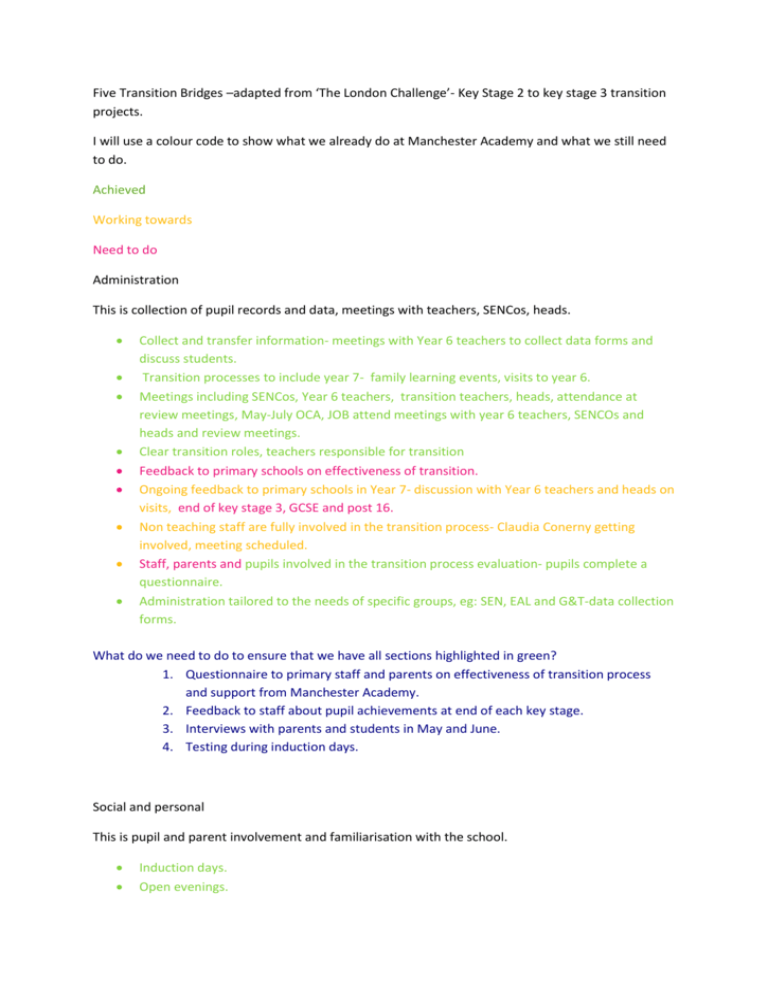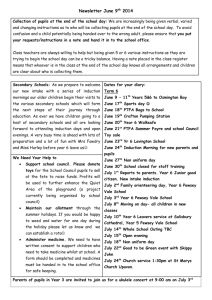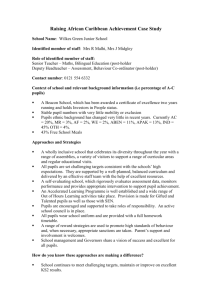Five transition Bridges Manchester Academy
advertisement

Five Transition Bridges –adapted from ‘The London Challenge’- Key Stage 2 to key stage 3 transition projects. I will use a colour code to show what we already do at Manchester Academy and what we still need to do. Achieved Working towards Need to do Administration This is collection of pupil records and data, meetings with teachers, SENCos, heads. Collect and transfer information- meetings with Year 6 teachers to collect data forms and discuss students. Transition processes to include year 7- family learning events, visits to year 6. Meetings including SENCos, Year 6 teachers, transition teachers, heads, attendance at review meetings, May-July OCA, JOB attend meetings with year 6 teachers, SENCOs and heads and review meetings. Clear transition roles, teachers responsible for transition Feedback to primary schools on effectiveness of transition. Ongoing feedback to primary schools in Year 7- discussion with Year 6 teachers and heads on visits, end of key stage 3, GCSE and post 16. Non teaching staff are fully involved in the transition process- Claudia Conerny getting involved, meeting scheduled. Staff, parents and pupils involved in the transition process evaluation- pupils complete a questionnaire. Administration tailored to the needs of specific groups, eg: SEN, EAL and G&T-data collection forms. What do we need to do to ensure that we have all sections highlighted in green? 1. Questionnaire to primary staff and parents on effectiveness of transition process and support from Manchester Academy. 2. Feedback to staff about pupil achievements at end of each key stage. 3. Interviews with parents and students in May and June. 4. Testing during induction days. Social and personal This is pupil and parent involvement and familiarisation with the school. Induction days. Open evenings. Moving on to High school booklet. Specialist visits- workshops, masterclasses. Joint sports events. Parent and pupil visits- Getting to know you evening, themed evenings, involving community, family learning. Enabling pupils to access their new learning environment with confidence, homebase or primary base, planning taking place for September 2010. Parents and pupils are effectively briefed about transition with opportunities for feedback, Open Evening presentation, parent induction sessions. Joint social events for year 6 and year 7, family learning evening. Identify pupils’ strengths and weaknesses, data collection forms. Use information from primary teachers about social groupings to create classes- data collection forms and meetings. Pupil peer mentoring pre and post transition and social support- sixth form lunchtime activities. Information to parents about pastoral support and differences in school- Getting to know you evenings, parents evening, family learning events. Newsletters to students, staff and parents at primary schools. Early opportunity for parents to discuss progress and transition- Getting to know you evening, Parent’s Evening. Anti-bullying policy made explicit to parents and pupils. Social, personal and pastoral arrangements for transition are tailored to the needs of SEN pupils- Circle time, extra induction sessions EAL- Reading scheme lessons, teaching group, extra induction sessions, G&T- teaching group, register. Introduction of new KS3 structure in planning for 2010. Pay particular attention to schools with one pupil- need to organise extra induction sessions for these students and meet with year 6 teachers of all future students not just schools with 3 or more pupils as we have done in the past. PSHE programmes on study skills, homework and organisation, bullying. What do we need to do to ensure that we have all sections highlighted in green? 1. Visits to schools which have one or two pupils coming to the Academy. 2. Organise extra visits to Manchester academy for pupils at schools where we receive only one or two students. 3. Set up a peer mentoring or buddying system- pupils in Year 7 responsible for ‘looking after’ students from their own primary schools. 4. Setting up a primary base or h9omebase for year 7. 5. Team building days organised in early autumn. Year group set up in teams. Each team faces cognitive and physical challenges. 6. Bonding weeks- residentials, it has been proven that students that have taken part in these residentials have shown improved confidence and self-esteem. 7. Summer schools- extra induction/ catch up classes. 8. PSHE programmes on study skills, homework and organisation. Curriculum This is about continuity in curriculum between Year 6 and 7. It is about ensuring that year 7 teachers build on the curriculum covered and seek to teach to pupils strengths. Use of data collected- setting classrooms, levels recorded by teachers in markbooks. Pupil tracking- emarkbook. Target setting- targets set in books, review day. Cross phase teaching- common curriculum topics. Curriculum maps from primary schools collected so we can build on primary curriculums. Dialogue between Year 6 and year 7 teachers about curricula. Teachers have knowledge of key stage 2 assessment, tracking and target setting processes. Sharing of quality of work expected in Year 6. Joint projects and cross phase activities- workshops. Summer projects- extra induction sessions for vulnerable students, work along with Louise Knotman from BIP. Catch up programmes for Year 7 literacy- Reading Scheme and Toe by toe. What do we need to do to ensure that we have all sections highlighted in green? 1. Cluster meetings- Staff from Maths, ICT, English, Humanities and Science department meet with the primary co-coordinators share schemes of work to avoid repetition and develop commonality. 2. Team teaching in primary and secondary schools. 3. Discussion about assessment and tracking. 4. Discussion about expectations of quality of work. 5. Development of topic-based work. Curriculum design 1. Year 7 students to reduce number of teachers they see each week. They could share the same teacher for English, Maths, Humanities and PSHE for example. 2. Full time members of staff to teach year 7. 3. Team leader for Year 7. 4. Recognise and meet the needs of the different starting points of learners: a. Identification of different groups of learners. b. Schemes of work and structure: i. Targeting and/ or securing level 5 in core subjects. ii. Support to target and secure level 4 in core subjects. iii. Support to target and secure level 3 in core subjects. iv. Support programme designed to develop basic skills in English, Maths and Scientific Enquiry. Success: behaviour, attitude, attendance and attainment. 5. Raise pace of learning for high attainers- 2 year key stage 3. 6. Provide focused and targeted support for learners who arrive with low prior attainment. Pedagogy This is about improving continuity in teaching and classroom practise between year 6 and 7 and ensuring cross-professional dialogue. 1. Understanding of primary approach to learning- training and dialogue needed. 2. Policies on learning and teaching shared across phases. 3. Common language for lesson planning, eg: starter, WALT, lesson objective, plenary, response partner. 4. Teacher exchange between primary and secondary teachers. 5. Lesson observations between primary and secondary teachers. 6. Team teaching. 7. Advanced skill teachers provide outside support- workshops at Manchester Academy by experienced teachers. 8. Joint training programmes. 9. Celebration of difference in learning, allow access to resources- ICT, workshops, master classes. 10. Groupings of students in Year 7 which reduce the impact of change, eg: same teacher for English, Humanities, PSHE. 11. Quality information to parents about teaching and classroom practise. 12. Common approach to learning environments- access to labelled resources, jobs, display of topics studied. 13. Evaluate approaches- OCA evaluating approaches used at other high schools to provide evidence. 14. Pedagogy tailored to needs of specific groups, SEN, EAL and G&T- Reading scheme groups, circle time- need to focus on a more primary approach- same TA, perhaps responsible for behaviour and rewards. What do we need to do to ensure that we have all sections highlighted in green? 1. 2. 3. 4. 5. 6. 7. 8. 9. 10. Observation of teaching at primary school. Teaching and learning policies shared. Linking transition to schools teaching and learning policy. Common language used in lessons, eg: WALT. Team teaching. Teacher exchange. Joint training programmes. Reduce number of teachers seen by pupils. Information to parents about teaching and classroom practise. Primary approach to learning. Autonomy and managing learning. This is ensuring that pupils are seen as active participants in the transition process. Introduce Year with preferred learning style questionnaire. Students complete questionnaire about experiences of transition at primary and end of year 7. What do we need to do to ensure that we have all sections highlighted in green? 1. Preferred learning style questionnaire. 2. Questionnaire to students about teaching and learning experiences.



![afl_mat[1]](http://s2.studylib.net/store/data/005387843_1-8371eaaba182de7da429cb4369cd28fc-300x300.png)



